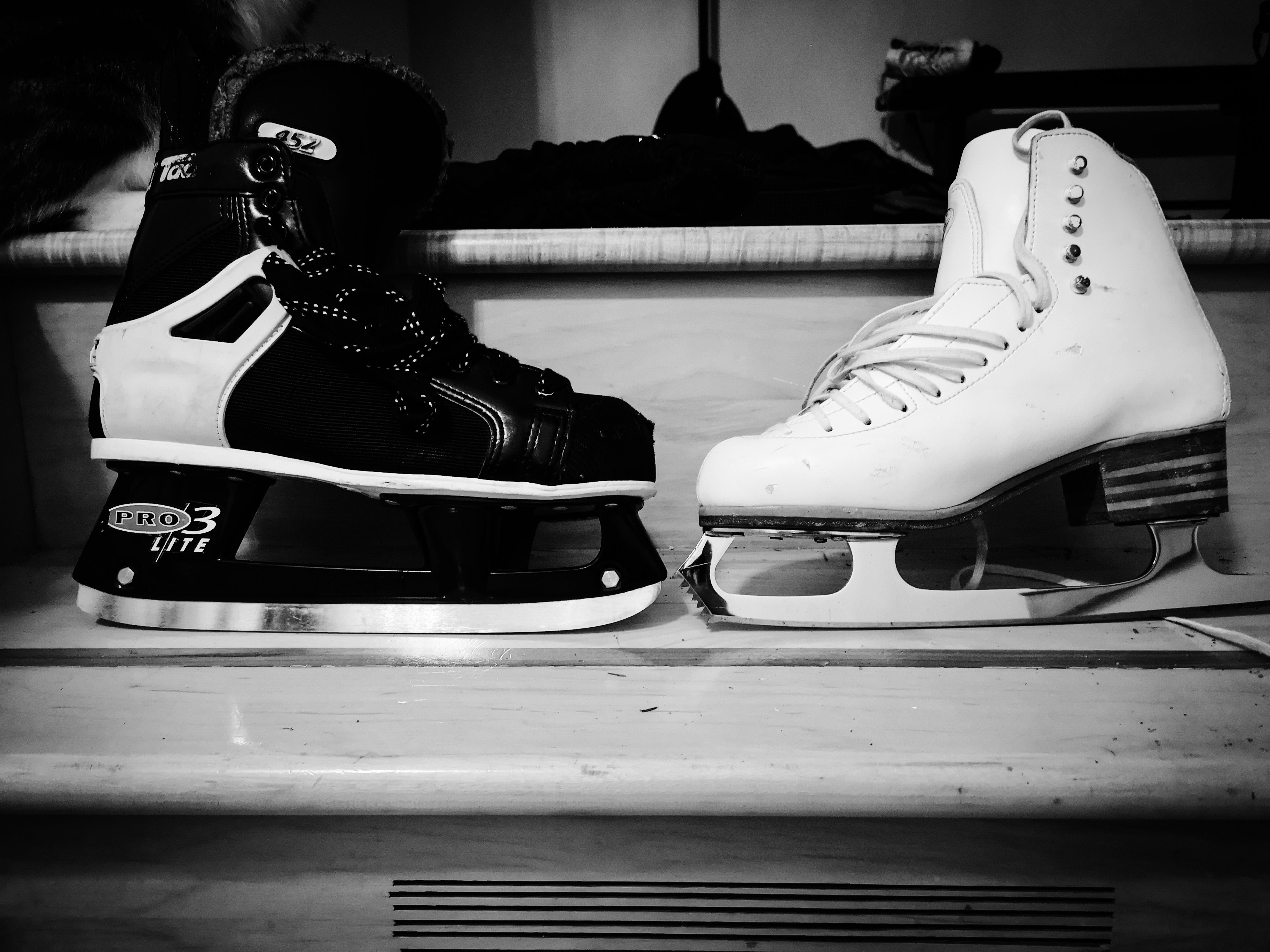Hockey skates and figure skates serve different purposes. Each type has unique features and benefits.
When comparing hockey skates and figure skates, it’s important to understand their differences. Hockey skates are designed for speed and agility on the ice. They have a snug fit for better control. Figure skates, on the other hand, are made for grace and precision.
Their blades are longer and have toe picks for jumps and spins. Comparing these skates helps you choose the right pair for your needs. Whether you’re aiming for swift movements in hockey or elegant performances in figure skating, knowing the differences can guide your decision. This blog will delve deeper into these distinctions, aiding you in making an informed choice.
Design Differences
When it comes to skating, the design of your skates plays a crucial role in your performance and comfort. Whether you’re gliding across the ice in a hockey game or performing graceful spins in figure skating, the design differences between hockey skates and figure skates are significant. Let’s break down these differences into two main categories: blade shape and boot structure.
Blade Shape
One of the most noticeable differences between hockey skates and figure skates is the blade shape. Hockey skates have shorter and more curved blades. This design allows for quick turns and fast stops. It’s perfect for the agility required in a fast-paced hockey game.
Figure skates, on the other hand, have longer and straighter blades. These blades extend beyond the boot, providing the stability needed for jumps and spins. The toe pick at the front of the blade helps figure skaters execute intricate footwork and jumps.
Think about how you want to move on the ice. Do you need the speed and agility of hockey, or the precision and grace of figure skating? Your answer will guide your choice in blade shape.
Boot Structure
The boot structure also varies greatly between hockey skates and figure skates. Hockey skates have a lower cut and are designed for maximum ankle support. They are often made of rigid materials to protect your feet from pucks and sticks.
In contrast, figure skate boots are taller and provide more flexibility. This design helps skaters point their toes and achieve a full range of motion. The boots are also padded to cushion the feet during jumps and landings.
Consider your comfort and the type of support you need. Are you looking for a sturdy boot for protection, or a flexible one for graceful movements?
Choosing the right skate is essential for your performance and enjoyment on the ice. Keep these design differences in mind as you make your decision. What matters most to you in a skate?
Performance Aspects
When choosing between hockey skates and figure skates, understanding performance aspects can help. Both types of skates serve different purposes. Knowing their performance differences is essential. This section explores how they differ in speed, agility, stability, and control.
Speed And Agility
Hockey skates are designed for quick movements. They provide excellent speed and agility. The blades are shorter and more curved. This design allows for rapid direction changes. Players can stop and start quickly. Figure skates, in contrast, emphasize precision. Their longer blades support smooth glides. Skaters can perform delicate spins and jumps. Quick turns are less critical.
Stability And Control
Figure skates offer more stability. The longer blades create a larger surface area. This helps maintain balance during intricate moves. The toe pick adds control for jumps and spins. Hockey skates focus on control for fast gameplay. The shorter blade enhances maneuverability. Players can make tight turns and sudden stops. Stability is sacrificed for agility.
Usage Scenarios
Hockey skates are designed for quick turns and speed, ideal for fast-paced games. Figure skates offer better control for jumps and spins, perfect for graceful movements on ice.
When choosing between hockey skates and figure skates, understanding their usage scenarios can help you make an informed decision. Whether you’re gearing up for a sport or just looking to glide around the ice for fun, each type of skate has its unique benefits and best-use cases. Let’s dive into the different scenarios where you might use hockey skates versus figure skates.Sports And Activities
Hockey skates are designed for the fast-paced, aggressive nature of ice hockey. Their blades are shorter and more curved, allowing for quick turns and sudden stops. If you love the thrill of team sports and high-speed chases on the ice, hockey skates are your best bet. In contrast, figure skates are crafted for grace and precision. Their longer blades provide stability and control, essential for executing jumps, spins, and intricate footwork. Aspiring figure skaters will find these skates indispensable for mastering routines and impressing judges with their elegance.Recreational Use
If you’re skating purely for fun, your choice might depend on your style and comfort. Hockey skates offer a snug fit and are built for speed, making them great for those who enjoy fast-paced recreational skating. They are also more durable, which can be a plus if you skate often. Figure skates, with their toe picks and longer blades, are better suited for those who like to take it slow and enjoy the art of skating. The added stability makes them a good choice for beginners who need extra balance while learning basic moves. Have you ever tried both types of skates? What did you notice about your performance and comfort? Your personal experience can guide you to the perfect pair of skates for your needs.
Credit: www.britannica.com
Skill Requirements
Hockey skates need agility and speed, while figure skates require precision and balance for complex moves. Both demand strong ankle support.
### Skill Requirements When deciding between hockey skates and figure skates, understanding the skills required for each is essential. Both types of skates demand a unique set of abilities and learning strategies. Let’s dive into the details to help you make an informed decision. ###Learning Curve
The learning curve for hockey skates and figure skates can be quite different. Hockey skates focus on speed, agility, and quick direction changes. If you’re new to skating, you might find the shorter, curved blade of hockey skates a bit challenging initially. But, with practice, the rewards are immense—think fast-paced games and quick maneuvers. On the other hand, figure skates have longer blades with toe picks. These toe picks help with jumps and spins but can trip you up at the start. Despite this, many find figure skating skills easier to master over time due to the blade’s stability. ###Technical Skills
Technical skills required for each type of skate also vary significantly. Hockey skates require you to master quick stops, tight turns, and rapid acceleration. These skates are designed for a sport where speed and agility are crucial. I remember my first time in hockey skates, trying to stop quickly without falling was a challenge. But once you get the hang of it, it’s exhilarating. Figure skates, however, demand precision and grace. You need to learn jumps, spins, and intricate footwork. The first time I nailed a spin on figure skates, the sense of achievement was incredible. The toe pick becomes your best friend for jumps and certain movements. Which set of skills do you think you’ll enjoy more? Quick, strategic gameplay or artistic, graceful movements?Comfort And Fit
Choosing the right skates is crucial for both hockey and figure skating. Comfort and fit play a significant role in performance and safety. Let’s compare hockey skates and figure skates in terms of comfort and fit.
Padding And Support
Hockey skates are designed with thick padding for maximum protection. The padding helps absorb impacts during fast-paced games. Hockey skates also have a stiff structure for ankle support. This stiffness is essential for quick turns and sudden stops.
Figure skates, on the other hand, have less padding. They focus more on flexibility and range of motion. The boots are generally softer, allowing for intricate movements. Figure skates also provide good ankle support but are not as rigid as hockey skates.
Customization Options
Hockey skates offer various customization options. Players can choose different levels of stiffness and padding. Some models even have heat-moldable features for a better fit. These options allow players to tailor their skates for comfort and performance.
Figure skates also offer customization, but the focus is different. Skaters can adjust the blade type and boot stiffness. They can also choose custom insoles and liners. These features help improve balance and control during complex routines.
Maintenance
Proper maintenance ensures the longevity and performance of your skates. Both hockey and figure skates need regular care, but there are key differences in how you maintain them. Let’s dive into the specific aspects of maintaining each type of skate.
Blade Care
Blade care is essential for both hockey and figure skates. Keep your blades dry to prevent rust. After each use, wipe them with a soft cloth. For hockey skates, sharpening is crucial. It ensures smooth gliding and better control. Sharpen your blades after every 10-15 hours of ice time.
Figure skates need regular sharpening too. Their blades are more delicate. They have a different edge and profile. Sharpen them after every 20-30 hours of use. Always use blade guards when off the ice. It protects the edges from damage.
Boot Upkeep
Boot upkeep is vital for comfort and support. Hockey skates have stiff boots. They need to be broken in gradually. Always dry them after use. Remove the insoles to let them air out. This prevents odor and bacteria buildup.
Figure skate boots are often made of leather. They require conditioning to keep them supple. Use a leather conditioner every few months. Store your skates in a cool, dry place. Avoid leaving them in direct sunlight. It can damage the material and affect the fit.
Cost Considerations
Choosing between hockey skates and figure skates can be challenging, especially when considering cost. Each type of skate comes with its own price range and value propositions. Let’s delve into the cost considerations for both to help you make an informed decision.
Price Range
The price of hockey skates generally starts lower than figure skates. Basic hockey skates can be found around $50 to $100. However, high-end models for professional players can go up to $900 or more.
Figure skates, on the other hand, usually start at about $70 for beginner models. Professional-grade figure skates can reach prices as high as $1,200 or more. You might find mid-range options between $250 and $600, offering a good balance of quality and affordability.
Value For Money
When it comes to value for money, consider how often you’ll use the skates and your level of expertise. If you’re a beginner, investing in high-end skates may not be necessary. Mid-range options can offer good performance without breaking the bank.
If you’re a frequent skater or plan to compete, investing in higher-end skates can be worthwhile. They offer better support, durability, and performance. For example, I once bought a mid-range pair of figure skates for around $300 and they lasted me through several years of competitions and practice sessions.
Think about your long-term goals and how much you’re willing to invest. Are you looking for something that will last through years of intense use, or just a pair for occasional recreational skating?
In conclusion, understanding the price range and value for money can help you choose the right skates. Whether you go for hockey or figure skates, making an informed decision will ensure you get the best bang for your buck.

Credit: www.youtube.com

Credit: connectingwithscience.org
Frequently Asked Questions
Is It Easier To Use Hockey Skates Or Figure Skates?
Hockey skates offer more ankle support and are generally easier for beginners. Figure skates require more balance and precision.
Is Hockey Skating Harder Than Figure Skating?
Hockey skating and figure skating each have their own challenges. Hockey focuses on speed and agility, while figure skating requires precision and artistry. Which is harder depends on individual skills and preferences.
What Type Of Ice Skates Are Best For Beginners?
The best ice skates for beginners are recreational skates. They offer more comfort and support. Look for skates with a snug fit and good ankle support.
Do Figure Skates Get Sharpened The Same As Hockey Skates?
No, figure skates are sharpened differently than hockey skates. Figure skates require a deeper hollow and precise edges.
Conclusion
Choosing between hockey skates and figure skates depends on your goals. Hockey skates offer speed and agility. Figure skates provide precision and grace. Both types have unique advantages. Consider your sport and personal preference. Try both if unsure. Each skate type enhances different skills.
Make your choice based on your needs. Enjoy your skating experience.




